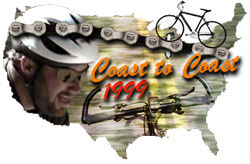

Prologue
Day 1 - 8
Day 9 -17
Day 18 -26
Day 27 - 33
Day 34 - 40
Day 41 - 48
Day 49 - 56
Day 57 - 64
Day 65 - 72
Day 74 - 78
Epilogue
Some things to consider when deciding which direction you want to travel:Winds: It not true that the wind always blows from the west. In Kansas they blew from the south. The crosswind was so strong it didn't matter what direction you were going in. In Wyoming the winds seemed to be always blowing from the west although when I passed riders going east they said they faced strong winds too. The winds blew from the east in Yellowstone. When you have a tail wind you usually don't realize it's there. When it's in your face, you never forget it. Either way, in the words of someone I met in Kansas "It's windy wherever you go".
Scenery: If I had started the trip in the beautiful Northwest I would have been spoiled for the rest of the trip. While the east does have it's beautiful spots (Virginia) it looks very similar as far west as the Mississippi. Going west you always have the beauty of the Rocky Mountains to look forward to. Once I reached them I truly felt like I was on vacation. If all I had to look forward to after leaving the mountains was Kansas and Kentucky I may have finished the trip faster to get it over with instead of enjoying the journey.
Elevation: The accents are much easier when taken from the east. Hoosier Pass is a gradual climb from the east (south). It's a steep climb from Breckenridge on the other side. It's along way to the top of the first mountain range in Oregon when coming from the West. Many eastbounders agreed going east to west is physically easier.
Time of year: Since I left in the Spring, I avoided the summer heat and humidity of the east. I passed eastbounders who were headed into 90-100 degree heat and high humidity. I was in the mountains and had temperatures ranging from below freezing on July 4th in Montana to over 100 in the Oregon desert (but it was a dry heat). Be sure to consider this when planning your trip.




